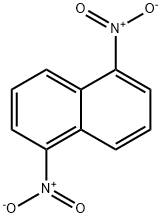1,5-Dinitronaphthalene

- CAS No.
- 605-71-0
- Chemical Name:
- 1,5-Dinitronaphthalene
- Synonyms
- 1,5-Dinitrophthalene;1,5-Dinitroaphthalene;1,5-DINITRO NAPHTALENE;1,5-dinitro-naphthalen;LABOTEST-BB LT00436936;1,5-DINITRONAPHTHALENE;Naphthalene,1,5-dinitro-;1,5-Dinitronaphthalene98%;1.5-Dinitronaphthalene 10;1,5-Dinitronaphthalene, 97+%
- CBNumber:
- CB9853955
- Molecular Formula:
- C10H6N2O4
- Molecular Weight:
- 218.17
- MOL File:
- 605-71-0.mol
- MSDS File:
- SDS
- Modify Date:
- 2025/1/27 9:38:02
| Melting point | 214 °C |
|---|---|
| Boiling point | 358.84°C (rough estimate) |
| Density | 1.58 |
| refractive index | 1.7040 (estimate) |
| solubility | Acetonitrile (Very Slightly), Chloroform (Slightly), DMSO (Very Slightly) |
| form | Solid:granular |
| Water Solubility | 60 ppm (12 ºC), 90 ppm (50 ºC) |
| BRN | 527184 |
| CAS DataBase Reference | 605-71-0(CAS DataBase Reference) |
| NIST Chemistry Reference | Naphthalene, 1,5-dinitro-(605-71-0) |
| EPA Substance Registry System | 1,5-Dinitronaphthalene (605-71-0) |
SAFETY
Risk and Safety Statements
| Symbol(GHS) |    GHS05,GHS07,GHS08 |
|||||||||
|---|---|---|---|---|---|---|---|---|---|---|
| Signal word | Danger | |||||||||
| Hazard statements | H315-H319-H335-H402-H317-H318-H341-H412 | |||||||||
| Precautionary statements | P201-P202-P264-P302+P352+P332+P313+P362+P364-P305+P351+P338+P337+P313-P308+P313-P405-P501-P273-P280-P305+P351+P338-P261-P501a | |||||||||
| Hazard Codes | Xi,Xn | |||||||||
| Risk Statements | 41-43-52/53-68-36/37/38 | |||||||||
| Safety Statements | 26-36/37/39-61-29 | |||||||||
| RIDADR | 2811 | |||||||||
| WGK Germany | 3 | |||||||||
| RTECS | QJ4551000 | |||||||||
| HazardClass | 6.1(b) | |||||||||
| PackingGroup | III | |||||||||
| NFPA 704 |
|
1,5-Dinitronaphthalene price More Price(2)
1,5-Dinitronaphthalene Chemical Properties,Uses,Production
Chemical Properties
Yellow to yellow-green needles or fluffy powder
Uses
1,5-Dinitronaphthalene is an intermediate in the production of naphthazarin (5,8- dihydroxy-1,4-naphthoquinone) and 1,5- naphthalenediamine, which is mainly converted to naphthalene 1,5-diisocyanate. As a sensitizing agent for ammonium nitrate explosives the use of mixed isomers is adequate.
Definition
ChEBI: 1,5-dinitronaphthalene is a dinitronaphthalene carrying nitro groups at positions 1 and 5. It has a role as a genotoxin.
Production Methods
Naphthalene is added slowly to mixed acid (22/58/20) at 40 ℃, and the temperature is raised to 80 ℃ over 4 h to give a mixture of 1,5- and 1,8-dinitronaphthalenes. The isomers are separated by fractional crystallization (e.g., from ethylene dichloride) or, preferably, by solvent extraction. The 1,5-isomer can be extracted with toluene, leaving 99 % pure 1,8- dinitronaphthalene. After evaporation of the toluene, the residue is extracted with a strongly polar solvent (e.g., sulfolane) to leave 99 % pure 1,5-isomer.
General Description
Yellowish white needles or light yellow fluffy solid.
Air & Water Reactions
Insoluble in water.
Reactivity Profile
1,5-Dinitronaphthalene is incompatible with strong oxidizers and strong bases. Mixtures with sulfur or sulfuric acid may explode if heated to 248° F .
Fire Hazard
Flash point data for 1,5-Dinitronaphthalene are not available; however, 1,5-Dinitronaphthalene is probably combustible.
Safety Profile
A suspected carcinogen. Mutation data reported. Mxtures with sulfur or sulfuric acid (used in commercial reactions) may explode if heated to 120℃. Initiation temperature depends on the quality of the dinitronaphthalene. When heated to decomposition it emits toxic fumes of NOx. See also NITRO COMPOUNDS of AROMATICHYDROCARBONS
1,5-Dinitronaphthalene Preparation Products And Raw materials
Raw materials
Preparation Products
1of2
chevron_right605-71-0(1,5-Dinitronaphthalene)Related Search:
1of4
chevron_right




